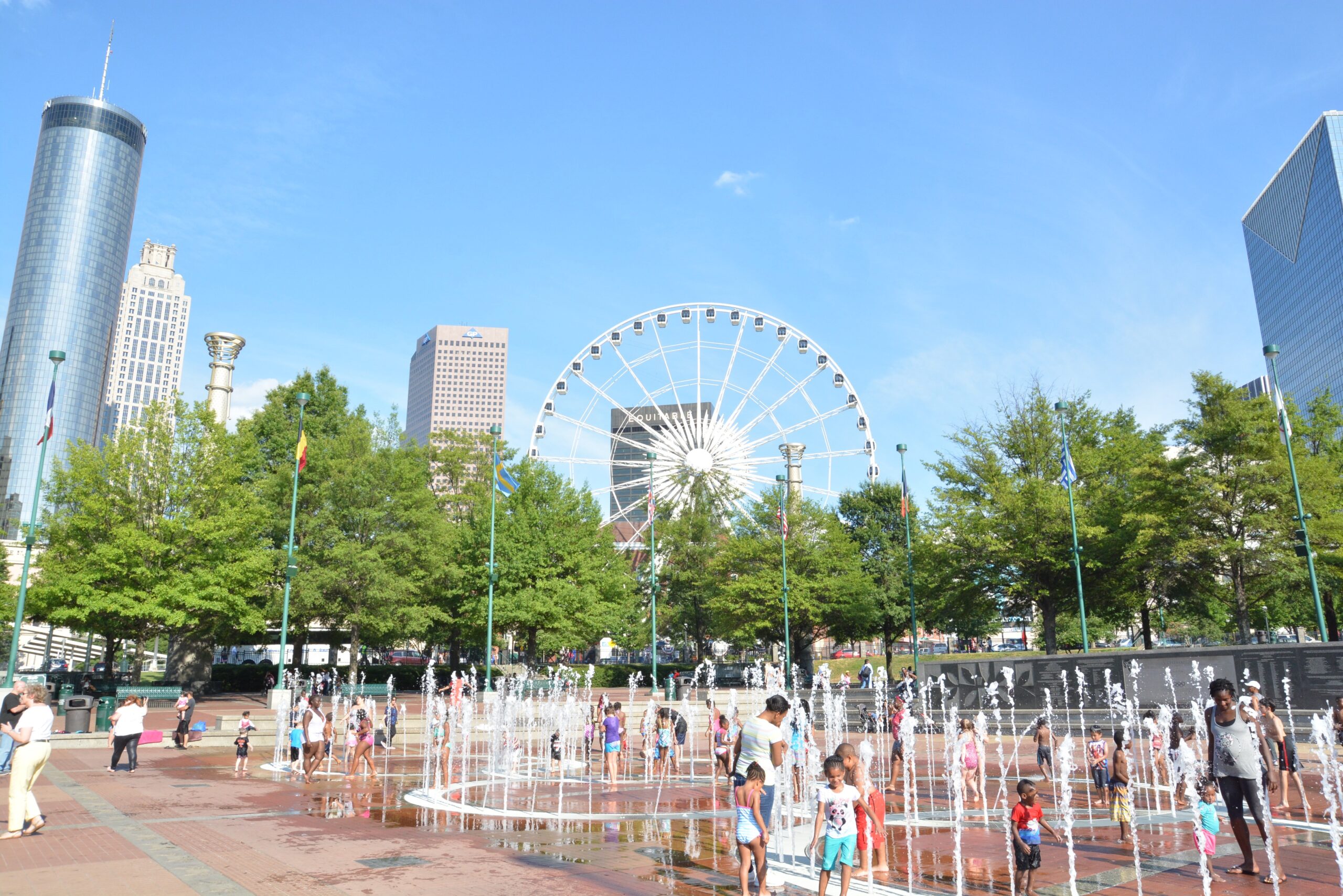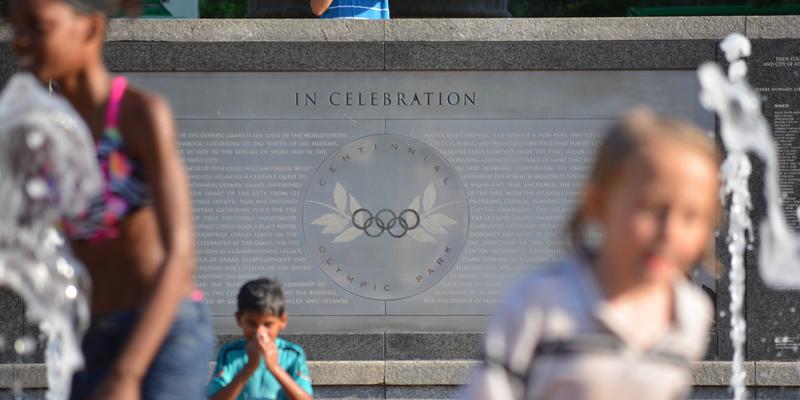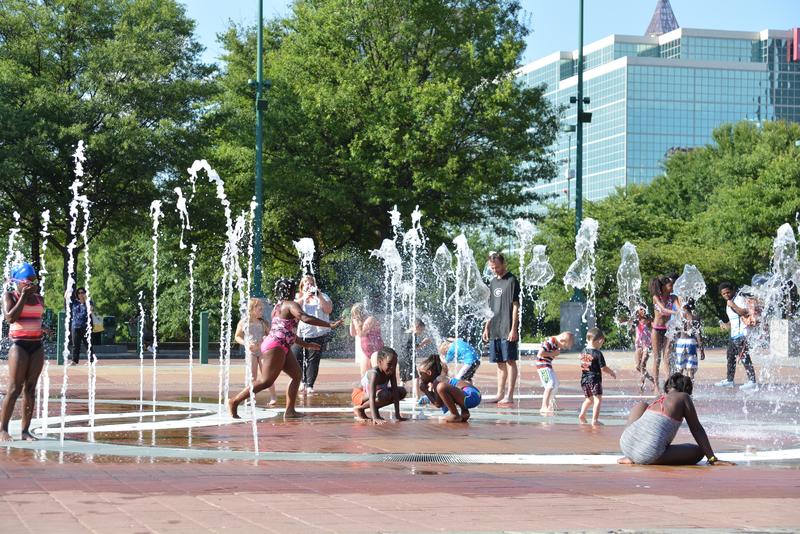Centennial Olympic Park Leaves Lasting Legacy On Atlanta Tourism

Alison Guillory / WABE
This story is part of “Atlanta Remembers: The 1996 Olympics,” WABE’s series on the impact of the 1996 Summer Olympics on Atlanta, 20 years later. For more stories, click here.
Pete Menzies and his 6-year-old son, Dylan, are in line to order milkshakes at a snack booth in Centennial Olympic Park in Atlanta.
“Chocolate,” comes Dylan’s request when asked what flavor he wants, mumbled into his dad’s leg.
Dylan is in the middle of a weeklong aquarium “camp.”
“You get to have some fun, and you get to see animals which are fishes and stuff like that,” Dylan explained.
The shakes have become a daily tradition this week.
“We walk from the Metro, past the CNN building, through the park, and we get ice cream shakes here,” said Menzies.
Of the 51 million visitors to Atlanta every year most of them will come here, said William Pate, president of the Atlanta Convention and Visitors Bureau.
“I think the park really became the centerpiece for the resurgence of tourism here in the city,” said Pate.
1996 Atlanta Olympic Venues: Where Are They Now?
Next to the aquarium is the World of Coke, the Center for Civil and Human Rights, seven attractions in total. This afternoon, about 50 children are playing in the Olympic rings fountain.
“That’s fairly typical for us in the summer. Pretty much every day,” said Frank Poe, executive director at the Georgia World Congress Center, which oversees the park.
“It is one of the very few legacy venues that is still activated, that people look up on and recognize that there was value gained from hosting the Olympics games beyond just the experience,” said Poe.
He points to the main field.
“This is where we host most of the larger events that’ll be in the park, so when we did three shows of Outkast a couple years ago,” he said.
Sixty thousand people turned out over three nights. But it was not always thus. Rewind 20 years?
“It was pretty much a rundown part of the center core of the city. Low rise buildings, abandoned, some that were in pretty bad shape. It was really not an area that one would wander into necessarily,” said Poe.
Today, wandering in is exactly what’s supposed to happen.
“You know if you think about the cities that people love to visit, you tend to have a starting point. San Francisco, you go to the wharf. New York, you go to Times Square. New Orleans, you go to Bourbon Street,” Poe said.
He said before Centennial Olympic Park, Atlanta didn’t really have one of those areas.
There’s a story that gets told about Centennial Olympic Park – that Atlanta’s chief organizer for the 1996 games looked out his office window at the warehouses that used to stand there and instead saw the green space in his mind.
“It’s just a bunch of water and kids and a fountain to us because we here, we see it every day, all day,” said Diamond, a cashier at one of the park snack vendors who didn’t want to give her last name. The fountain is her daily view at work, but she gets why it’s exciting for tourists.
“Everything in Atlanta that you could want ─ the Phillips, the Dome, the Congress Center, everything with civil rights movement, it’s literally all in this area. You can park and you can literally walk wherever you want to go,” she said.
Not everyone thought the success of the park was a given. Tom Weyandt, a longtime urban and transportation planner in Atlanta,was quoted in a New York Times article from around when plans for Centennial Olympic Park were first being floated.
“It’s a vision sort of dropped from on high, another big fix. But I think the soul of the city and the real vision of the city is in a lot of little things that this will distract us from and draw money away from,” he told The New York Times.
“I thought that quote would come back to haunt me one day,” he said two decades later, chuckling.
Actually, Weyandt said he wouldn’t take it back, and that it kind of still applies to Atlanta today. He said for sure, the city is better off today with the park, than without it.
“What has made Atlanta vibrant is what’s happened in neighborhoods, what’s happened along the BeltLine, Little Five Points, Old Fourth Ward,” Weyandt said.
Atlanta Olympics Helped GSU Shake Off Commuter School Image
He said of course, tourism and the draw of downtown is hugely important to Atlanta, but Weyandt said it’s the human scale things that give a place value.
“Those huge investments, in a way they’re easier to do than the smaller investments. They’re easier to do than say we’re going to have a first class public education system, we’re going to make sure there’s affordable housing for everyone in the system. That’s hard to do,” said Weyandt.
He said 20 years on, and with more huge developments coming down the pike, “we still are left with an extraordinary concentration of low income in the south and western parts of the city. We’re still left with very struggling neighborhoods.”
He said he hopes it’s those Atlanta neighborhoods that see more growth. Tourism ─ Atlanta has that figured out.
9(MDAxODM0MDY4MDEyMTY4NDA3MzI3YjkzMw004))








